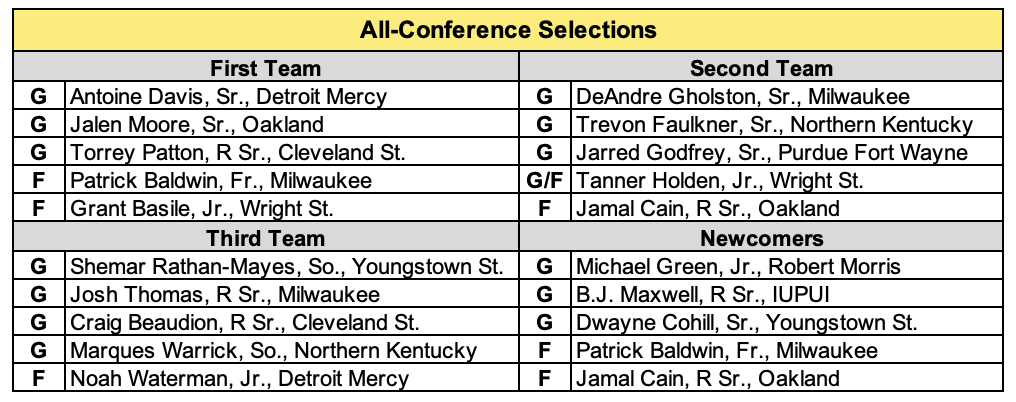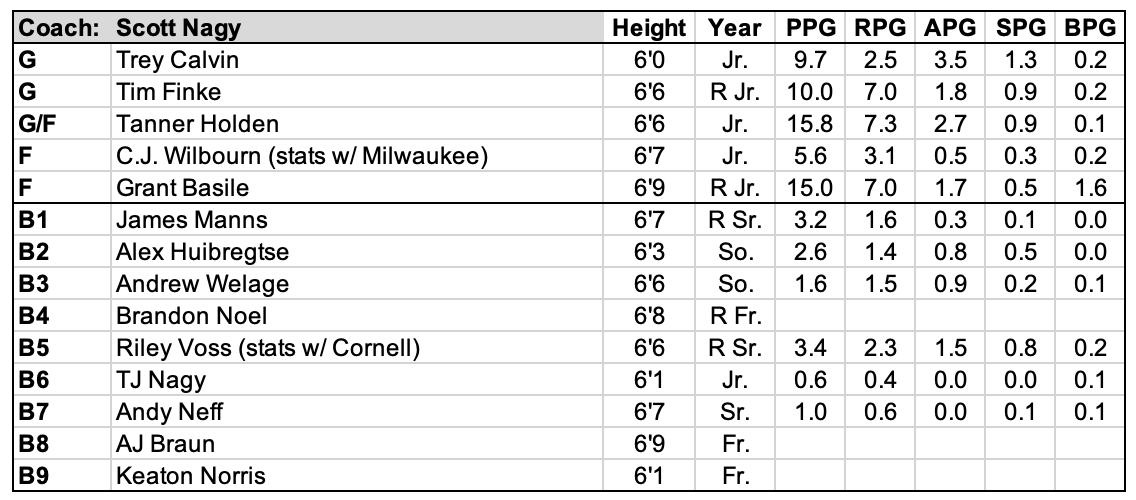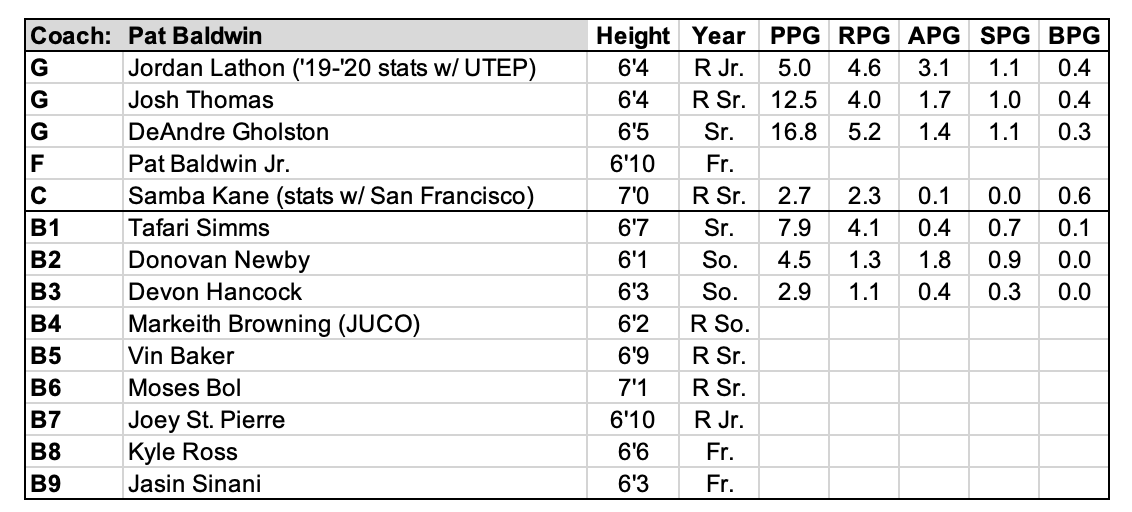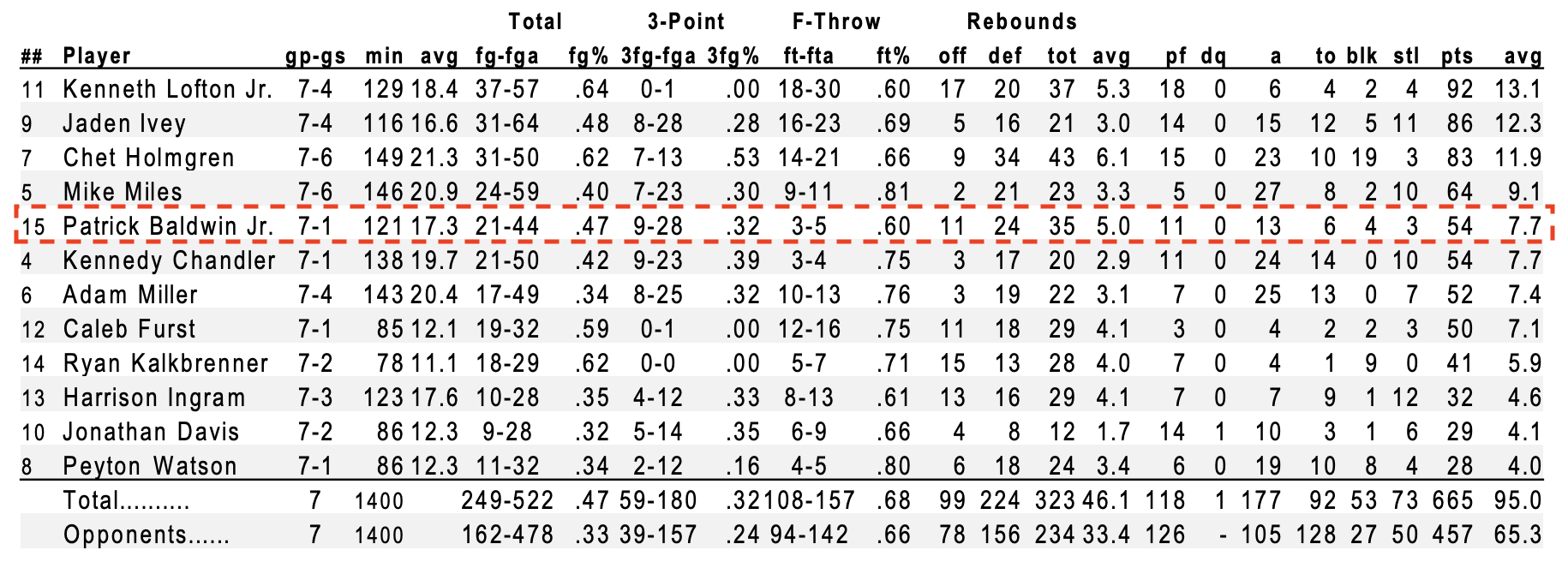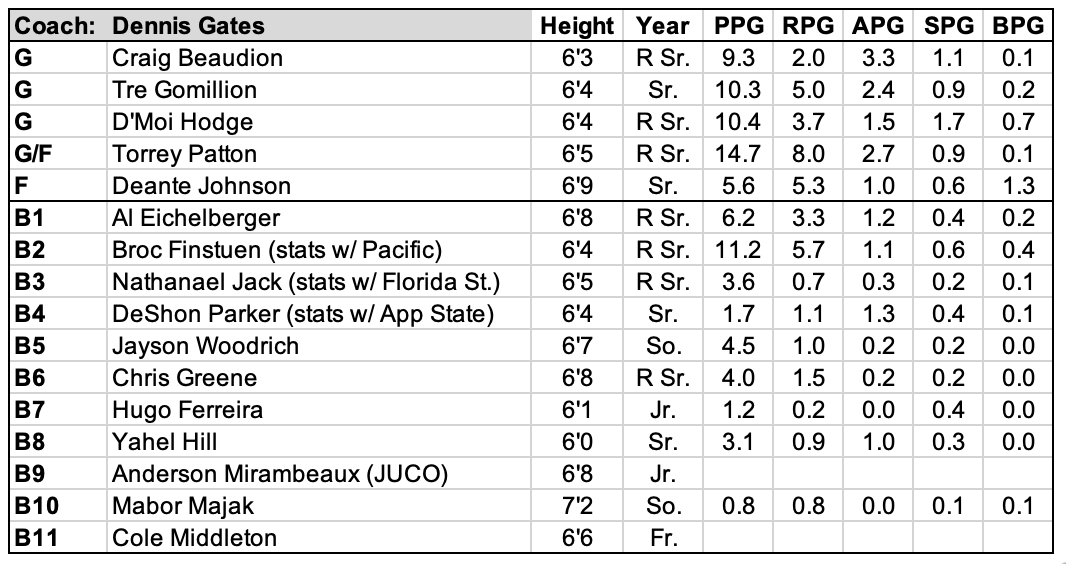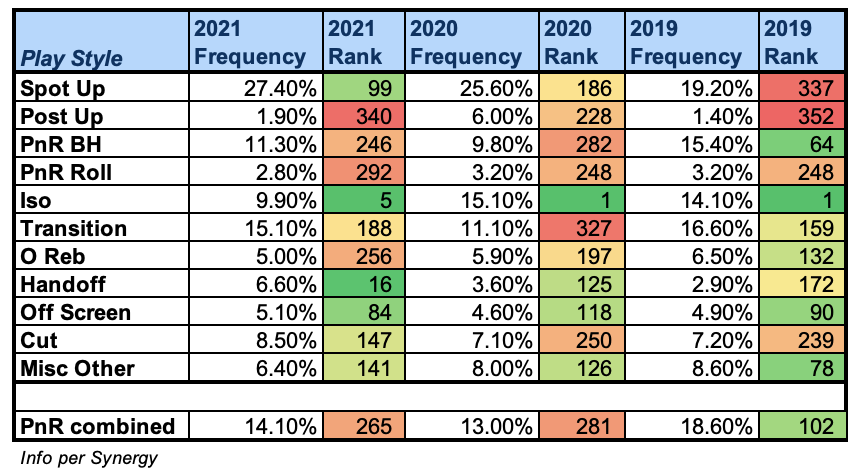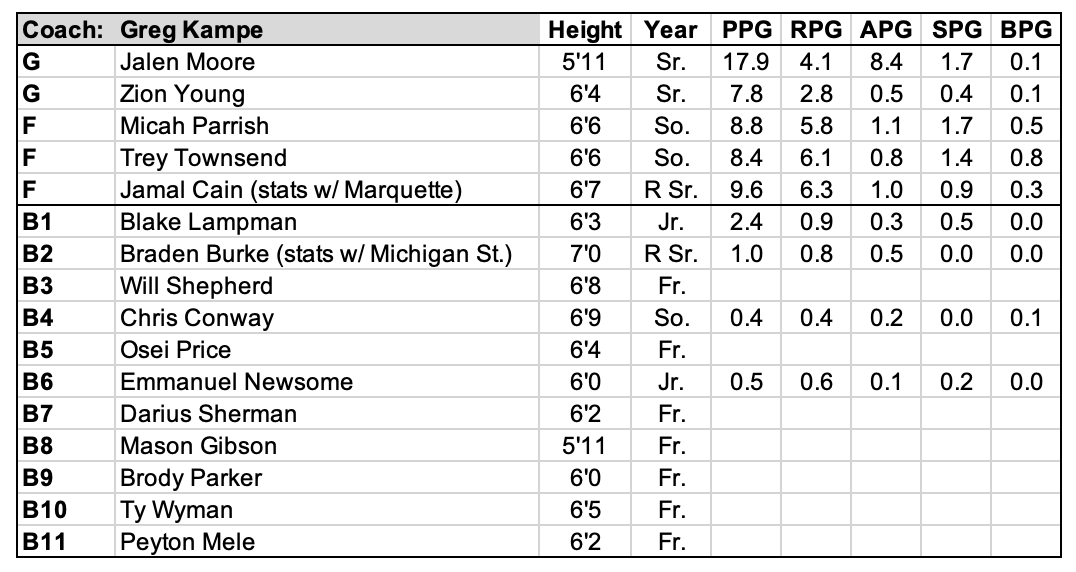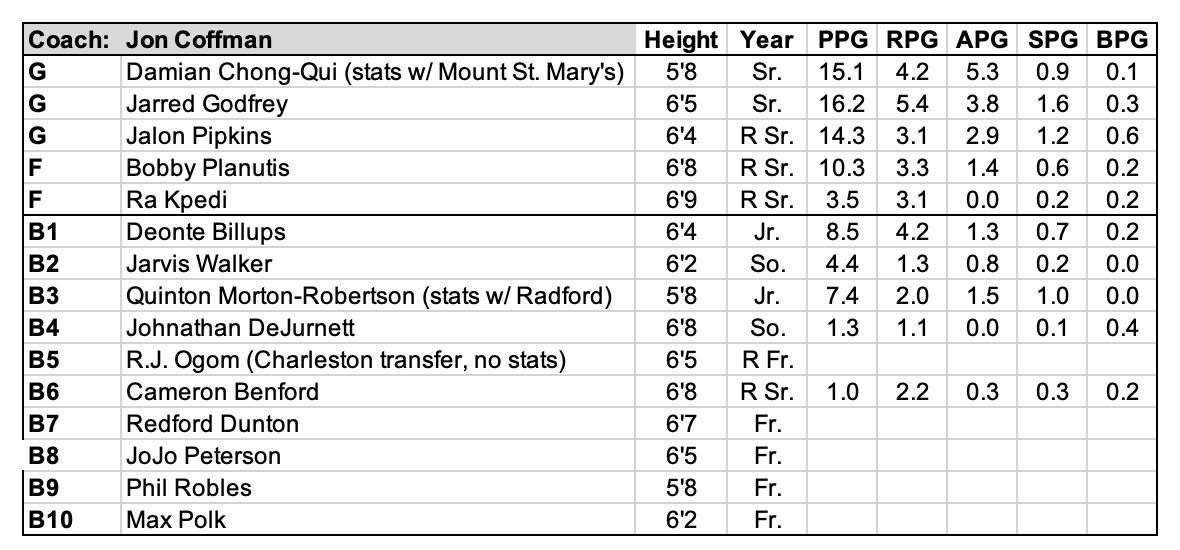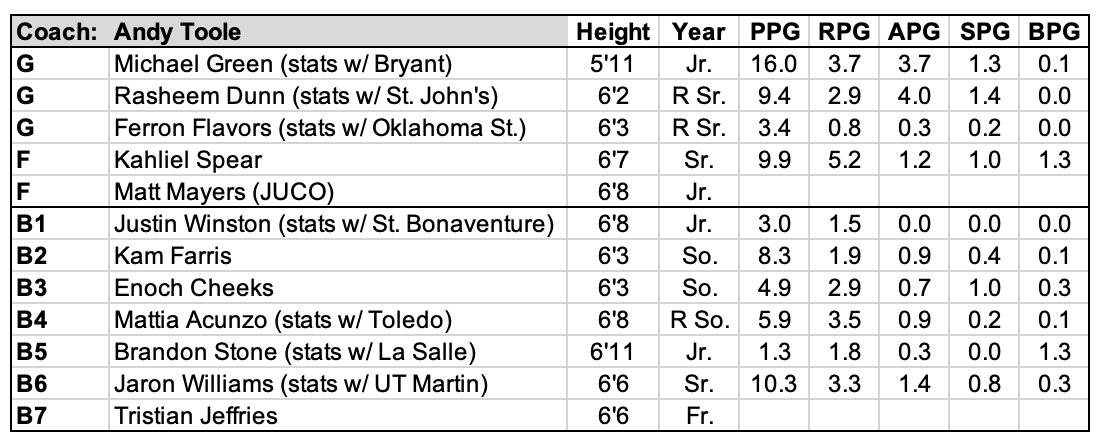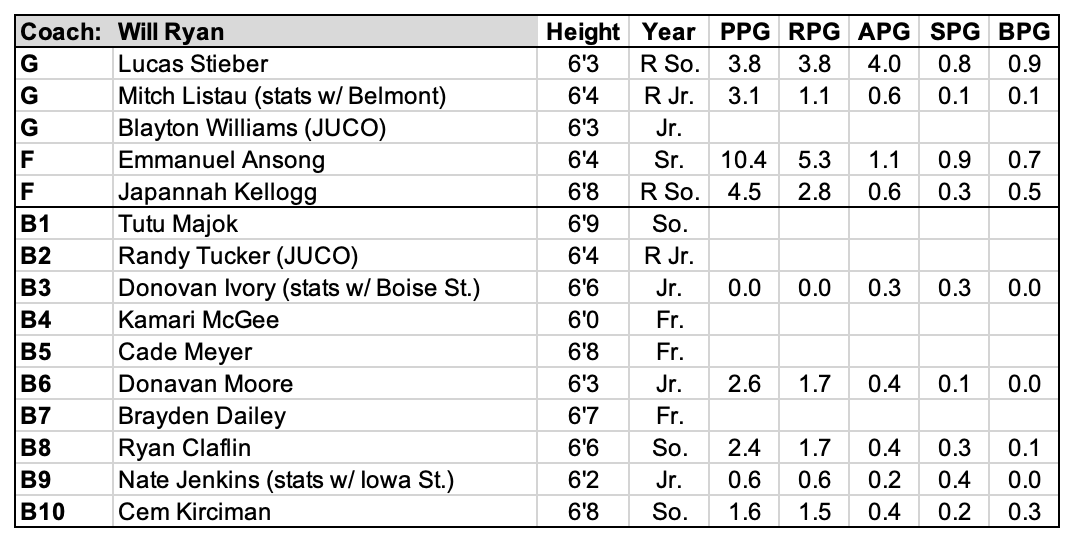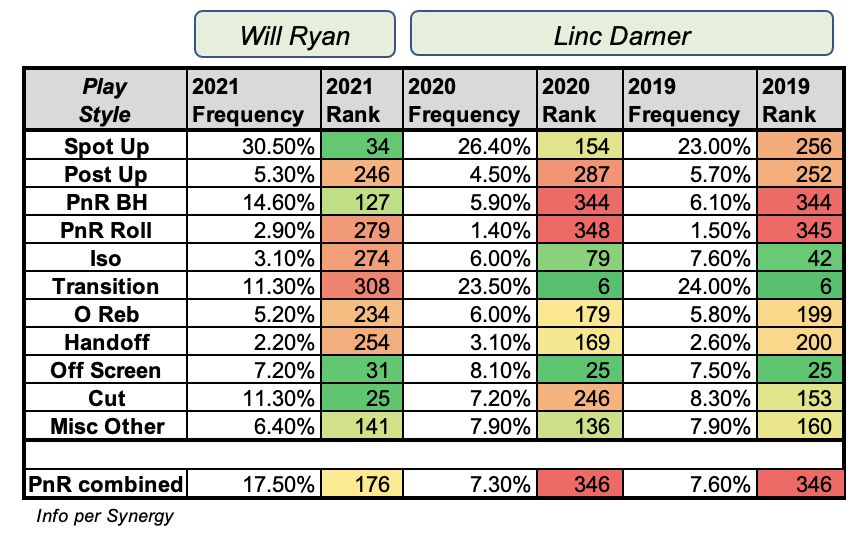-Matt Cox
Preseason Predictions
Co-Players of the Year: Patrick Baldwin, Fr., Milwaukee / Antoine Davis, Sr., Detroit Mercy
Coach of the Year: Pat Baldwin, Milwaukee
Newcomer of the Year: Patrick Baldwin, Fr., Milwaukee
Freshman of the Year: Patrick Baldwin, Milwaukee
Tier 1
1. Wright State
Key Returners: Tanner Holden, Grant Basile, Trey Calvin, Tim Finke
Key Losses: Loudon Love
Key Newcomers: CJ Wilbourn (Milwaukee)
Lineup:
Outlook: Is Scott Nagy the most underrated coach in mid major kingdom? He should consider lobbying for a complete elimination of all conference tournaments, and, alternatively, champion a model that awards the regular season champion an automatic berth to the big dance. But, in this reality, to the postseason victor go the spoils, not the other way around. And thus, Nagy’s national cache remains relatively dim.
The Raiders, winners of three straight league regular season league titles with no NCAA Tournament appearance to show for it, will aim to shake the monkey off their back in 2022. No one hates the ‘but [insert coach] can’t win the *big one*!’ narrative more than this guy, so please direct all such comments to another outlet. Nagy is the bomb-diggity, period. Recent conference tournament hiccups notwithstanding, his year-to-year consistency is simply unmatched.
That consistency stems from a distinct identity. Under Nagy, Wright State’s become a big man oasis, where all lumbering ogres are welcomed with open arms. Nagy weaponizes this size and strength over smaller Horizon adversaries like a giant club.
Look no further than Synergy’s breakdown of Wright State’s offensive playbook. Nearly 20% of all the Raiders’ possessions ran through the post last year – for context, only Purdue utilized a higher frequency of post-up possessions:
The million-dollar question is how this holds up without Loudon Love, who effortlessly tossed around helpless defenders like Raggedy Ann dolls.
No sweat here. Nagy always has the big man assembly line churning.
The cat’s out of the bag on Grant Basile, a 2nd Team All Horizon performer last season. Often overshadowed by Love’s imposing presence, Basile emerged as the go-to-guy in the dog days of conference play. Shame that 35-point / 14-rebound destruction of Milwaukee’s frontline in the Horizon Tournament was a complete waste (woof, what a meltdown that was).
James Manns, another member of WSU’s big man battalion, could be following in Basile’s footsteps, in store for a similar eruption. He’ll slide into Basile’s former role as the deputy paint patroller. Horizon League loyalists know how criminally underrated Manns is. The fact that he chose to stay put and not bolt for greener pastures is a testament to Nagy’s program stability.
Manns can do damage on the block, but he’s also a mid-range assassin, able to face up and knock down a 10–15-footer with ease. However, Manns’ range extends far beyond that – he’s drained 33 of his 77 3-pointers over the last three seasons, evidence of his pure shooting stroke. This ability to stretch the defense is what distinguishes Manns and Basile from Love, who struggled with his finishing touch at times. They’re not high-volume shooters by any stretch but they won’t hesitate to make the defense pay for sagging off. Collectively, Basile and Manns canned 28 of their 60 triples last season.
As much as I loved Love (ha), this ultra-bullish Wright State ranking is rooted in a fundamental misconception about his impact. Perhaps I’m underselling the intangible tenacity and toughness he brought to the table but the following chart from hooplens.com is eye-opening:
To put a pin in my previous, “Love was not a great finisher” take, refer to ShotQuality.com’s player-specific shot charting. Love’s ‘At Rim’ efficiency graded out in the 53rd percentile among all D-I players, a devastatingly low score for a man of his stature.
Despite owning a substantial size advantage over most Horizon squads, Nagy won’t settle for a methodical, ground-and-pound offense. Last year marked the second straight season the Raiders shifted into overdrive, as Wright State clocked the Horizon’s second fastest offense for the second year in a row (per KenPom’s adjusted offensive tempo).
At initial glance, it seems contradictory to the roster’s interior strengths, but it’s easy to extrapolate the method behind this madness: the team with a talent advantage should always seek a higher possession game. Nagy doesn’t ignore his bread and butter (scoring inside) to chase some pace-and-space pipe dream – rather, he simply understands the math behind playing a higher possession game. Against lesser talent, increasing possessions limits the variance risk of a potential upset (though, yes, this occasionally can backfire).
Nagy’s roster will again boast exceptional inside-out balance and interchangeability. Tanner Holden is the poster boy of such versatility, a robotically efficient, jack-of-all-trades southpaw. Holden’s shot chart efficiency profile, courtesy of ShotQuality.com, is stellar – there are few holes in his scoring arsenal:
Holden’s an excellent slasher and above average passer, but the calculated Trey Calvin returns to run point as the primary ball handler. Calvin sat backseat to the accomplished Cole Gentry in 2020, an invaluable learning period that paid major dividends last year. Shooting isn’t Calvin’s forte, but his mastery of Nagy’s motion-intensive offense is worth its weight in gold.
That weaves us into a quick PSA tangent, directed at all Wright State opponents:
Play zone!
The Raiders are far less proficient offensively against non-traditional, non-man-to-man defenses, which largely renders Nagy’s half-court playbook moot. It also forces the Raider forwards to operate in uncomfortable, awkward positions on the floor, away from their usual sweet spots. This zone over man decision comes at a cost – a bloodbath on the offensive boards is one such risk – but any chess move that takes the Raiders out of their offensive comfort zone is well worth the investment.
Ok, back to the roster breakdown. The Raiders will look to sustain the league’s top defense for the second year in a row, anchored by wing stalwarts Tim Finke and CJ Wilbourn. Finke proved to be a home-run acquisition from Grand Canyon after etching his name on the All-Horizon Defensive team last year. Wilbourn, an inter-conference transfer from Milwaukee, will look to make a similar splash. He knows the Horizon like the back of his hand after starting 41 games over his first two seasons at Milwaukee. Wilbourn’s not flashy but he’s another reinforcement for the Raiders’ interior muscle. A late injury left Panther fans wanting more from Wilbourn last season, a year removed from receiving All-Freshman accolades as a rookie.
Lots of unproven underclassmen comprise the rest of the roster, but Nagy’s player development track record is nothing short of sterling. As of now, the most polished of these somewhat unknowns is ‘sharpshooter’ Alex Huibregtse – ‘sharpshooter’ by reputation, that is. The Wisconsin native made less than 30% of his long ball attempts last year, a clip that must improve if he wants to remain an asset in the top-8 of the rotation.
Like Huibregtse, sophomore Andrew Welage is also regarded as a knockdown shooter, but we’ll hold out judgment until he makes more than one three in a season (he was 1-for-7 from 3-point range last year).
Bottom Line: In college basketball’s most efficient conference, it’s no coincidence that Wright State and Cleveland State rose to the top of the standings last year, the league’s only two defensive-minded squads. There’s no shortage of buzz around those Vikings – not to mention the 5-star blue-chipper about to take the floor for Milwaukee – but I refuse to bet a different horse in this year’s race.
Tier 2
2. Milwaukee
Key Returners: Josh Thomas, DeAndre Gholston
Key Losses: Te’Jon Lucas
Key Newcomers: Patrick Baldwin Jr., Jordan Lathon (UTEP), Samba Kane (San Francisco), Markeith Browning (JUCO), Moses Bol (UCF), Vincent Miszkiewicz (D-II)
Lineup:
Outlook: Move over Antoine and Mike Davis. There’s a new Horizon League father-son duo in town!
Thanks to fortuitous timing, and a dose of nepotism, Pat Baldwin Sr. bagged the white whale right from his own backyard. For 99% of 5-star, NBA lottery caliber prospects, the Horizon League is a flyover conference. To Pat Baldwin Jr., it’s a familiar playground. Ever since his father became the basketball dean at UWM back in 2017, it’s been baby Baldwin’s home away from home.
There’s not much to say that hasn’t already been spewed about Baldwin’s enviable talents. At 6’10, he masquerades as a point forward, multi-purpose combo guard. He’s an adept handler and passer, but Baldwin’s poetic shooting stroke is what sets him apart from the other blue-chip recruits.
Unfortunately, PBJ’s high school farewell tour was cut short last season, ended abruptly by a severe high ankle sprain. As detailed by the Milwaukee Journal Sentinel, this kept him on ice until the Team U19 training camp this summer. The 7-game U19 tournament gave us a brief peek behind the curtain at Baldwin’s post-injury status.
The PDF screenshot below show how Baldwin stacked up against his cream of the crop peers on the world stage. His per minute production and efficiency were far from spectacular, but the highlight reel video below is what to watch. Not only is his jumper pro-ready now and but his comfort level attacking the rim is light years beyond most teenagers, too:
Baldwin is the magnet drawing 99% of all Panther preview content this summer but a one-man-band won’t vault Milwaukee to the top of the Horizon totem pole. Wright State’s taken up permanent residency there the last few seasons, enabled by a supersized frontline and a devout commitment to defensive excellence. Baldwin appears to be mirroring that formula, at least on paper, based on the rejuvenated roster for 2022.
Samba Kane (waiver) and Moses Bol (injury) are both cleared for takeoff, two monstrous barricades in the middle. Kane’s production at USF was slightly underwhelming, given the cavernous vacancy in the Dons’ frontline. Still, he’s worthy of clocking 15 minutes a game as a garbage man. Bol’s another high risk, high reward asset coming off injury. Bol’s rosy outlook is rooted in his JUCO production back in 2019 - playing in one of the toughest leagues in Division-I JUCO, Bol swatted five shots a game on a per 40-minute basis, earning him Honorable Mention All-Conference.
Vin Baker Jr., who hasn’t played in two full seasons, is another wildcard from Boston College. As an unseasoned rookie, Baker was a fringe roll player on a bottom tier ACC team, and has seen minimal live game action since then. Despite the alluring size and skill combination, I’m curbing my enthusiasm regarding Baker’s prognosis for 2022.
From Te’Jon Lucas to Jordan Lathon, the Panthers will trot out another lauded high school recruit (top-100) seeking a fresh start and change of scenery at point guard. Injuries kept Lathon on the backburner last year after transferring in from UTEP but he’s a legitimate triple-double threat every time he steps on the floor – at 6’4, Lathon bears a striking resemblance to former SLU guard Jordan Goodwin.
Between Lathon and the incumbent twofer of Josh Thomas and DeAndre Gholston, this backcourt is overflowing with depth. Gholston and Thomas are two established All-Conference caliber guards. After setting the league ablaze during February, this duo must ground themselves in this new reality. Can they embrace, and thrive in, a lesser offensive role? With all this talent in stock, the days of averaging 20 points a game are long gone.
The depth continues with JUCO import Markeith Browning, who was a full-time starter on reigning NJCAA champion Coffeyville. Given Baldwin’s success rate with JUCO prospects (Gholston, Thomas and Tafari Simms are notable precedents), Browning’s a safe bet to make an immediate impact. Speaking of Simms, he was virtually unstoppable in two conference games last year, pouring in 32 and 24 points against IUPUI and Purdue Fort Wayne, respectively. A foot injury interrupted that momentum midway through the year but there’s no reason to think he’ll be relegated to the back of the line, either. Donovan Newby, a reliable shooter, and measured decision maker, did nothing wrong in his freshman campaign, while fringe 3-star rookie Kyle Ross, a virtual afterthought on this roster, is waiting in the wings as well.
Bottom Line: From limitless positional size to vaunted talent pedigree, this squad is simply too gifted to fail. How high the Panthers fly, however, will be decided under one roof: the Baldwin household. Can PBJ deliver on the prophecy laid forth by his lofty recruiting ranking? Can Pat Sr. push all the right buttons and rally the troops?
3. Cleveland State
Key Returners: Craig Beaudion, Tre Gomillion, D'Moi Hodge, Torrey Patton, Deante Johnson, Al Eichelberger
Key Losses: Alec Oglesby
Key Newcomers: Broc Finstuen (Pacific), Nathanael Jack (Florida St.), DeShon Parker (App State)
Lineup:
Outlook: Someday, Dennis Gates will have his pick of the litter. The 2X Horizon League Coach of the Year has completely washed away the stink left behind by Dennis Felton. Cleveland State fans, cherish every day Gates is still roaming your sidelines. They are a blessing (and they are likely numbered). Now, the former doormats have a target on their back, entering the 2022 campaign with sky high expectations, as the reigning regular season co-champions return everyone of significance.
Gates’ secret sauce to success is as cliché as it is real: form unbreakable player / coach bonds and get every guy rowing in the same direction. Gates denounces star power and advocates depth, evidenced by the laundry list of heroes that emerged during last year’s magical run. In today’s climate, this approach seems risky, but Gates somehow makes it work. All around the country, kids are moving in and out of programs like patrons on the NYC subway, desperately searching for a landing spot that will guarantee them 25-30 minutes a game. Gates, somehow, sells the opposite… and it works…
The brilliance of Gates’ blueprint is its immunity to injuries. The Vikings dealt with their fair share of nicks and dings last year but a stable of options across all five positions acts a buffer to any unforeseen roster blow ups. That said, Gates did lean heavily on a core group of five, which started every single game from December 13th onward. Calculated floor conductor Craig Beaudion, defensive stalwart Tre Gomillion, scoring sparkplug D’Moi Hodge, do-everything wing Torrey Patton and gritty garbage man Deante ‘Spider’ Johnson.
Unselfish is the first word that comes to mind with this nucleus, making them hard to distinguish when they’re on the floor together. Hodge was the crown jewel of last year’s newcomer crop, a lauded JUCO recruit with a flammable scoring streak. Patton’s production is as certain as death and taxes, as is Gomillion’s dogged defense at the point of attack. Johnson does the dirty work inside, while Beaudion sets the table from the the outside.
That’s just the tip of the iceberg, though, as Horizon foes quickly learned last year. Big Al Eichelberger is the ultimate ace-up-your-sleeve, a big man relic from the 90s brought back to life. Injuries limited his production last season, but big Al can take over a game at will, especially against weaker frontline inside. Yahel Hill and Jayson Woodrich each saw high intensity minutes last year, but they’ll bump shoulders with a trio of newcomers for sustained run: Broc Finstuen, Nathanael Jack and DeShon Parker. Finstuen hails from a similar culture at Pacific, where Damon Stoudamire preached the same ‘all hands-on deck’ mantra. He’ll offer an immediate jolt to the backcourt as another thick guard who can plug a variety of holes on both ends. Heck, I haven’t even mentioned Chris Greene yet, who I personally watched take over multiple games last season for brief stretches. He may not even see the floor some nights behind this long queue of options.
All that said, let’s quickly splash some cold water on the blazing inferno that is the Cleveland State hype circus this summer. First off, the Vikings undeniably benefitted from serendipitous shooting luck – CSU’s opponents made a tick over 30% from downtown against the Vikes in conference play last year. I expand on this dynamic in the IUPUI preview below (another team whose defensive improvement was buoyed by fortuitous defensive 3PT%) but it’s statistically unlikely CSU replicates that in consecutive seasons.
Also, the regression monster is lurking from Cleveland State’s side as well. Per hoop-math.com, the Vikings made 41% of their 2-point jumpers last year, which ranked in the top-60 nationally. A valid rebuttal is that CSU boasts multiple guys who are proficient mid-range shooters (I subscribe to that take), implying there’s no regression coming in this regard. That said, mid-range shooting is largely variable from year to year, so don’t be surprised to see deterioration in this domain.
ShotQuality.com’s ‘Record Luck’ metric serves as an all-encompassing measure for quantifying the impact of these regression forces. Based on the expected points per possession on Cleveland State’s own shot attempts and their opponents’ shot attempts, SQ projected a final record of 14-13 last year. Relative to the actual efficiency on those same shots, Cleveland State was the 5th ‘luckiest’ team in America last season.
Pardon my devil’s advocate alter ego hijacking the preview but the Vikings deserve a critical eye when assessing them through the lens of Horizon League title contenders. In any sport, there’s some degree of luck infused in every great season and these statistics simply indicate that CSU was abnormally boosted by those factors.
Bottom Line: Picking Cleveland State outside the top-2 is going to be an unpopular opinion, but context is critical in this year’s Horizon landscape. For starters, the gap between #2 and #6 is teeny tiny – like, virtually nonexistent – so, in that light, Tier 2 projections should be interpreted as #2B or #2C or #2D…
Also, remember, the upper echelon of this league hasn’t been this good in over five years, probably. Northern Kentucky is running it back with a copy / paste roster from last year. Milwaukee and Detroit are hoarding sublime crops of talent. Wright State is, well, Wright State. Perhaps 2nd place is a more prudent projection here, but the Vikings are certainly not the prohibitive favorite.
4. Northern Kentucky
Key Returners: Bryson Langdon, Trevon Faulkner, Marques Warrick, David Bohm, Adrian Nelson
Key Losses: Adham Eleeda
Key Newcomers: Chris Brandon (Detroit), Seybian Sims (North Dakota)
Lineup:
Outlook: John Brannen is a tough act to follow. Well, was a tough act to follow (the whole Cincinnati thing didn’t pan out so well).
Darrin Horn, so far, hasn’t disappointed. Through two seasons, the former South Carolina head honcho is 24-11 in the Horizon, with a 2nd and 4th place finish under his belt. Not too shabby, right? Everybody not named Adham Eleeda is back in the saddle for another chase at postseason glory, which was rudely stripped away by COVID in 2020.
The Norse will go as far as their perimeter triumvirate takes them, headlined by a pair of upperclassmen in Trevon Faulkner and Bryson Langdon. Langdon is technically the point guard by conventional position nomenclature, but Faulker is the Norse’s true ticker. Think mini-James Harden without the jump shot. He’s a relentless rim hunter, always probing the defense for open seams through which to attack. He welcomes contact with open arms, and, coupled with his ‘goofy’ southpaw finishing techniques, racks up a ton of fouls and trips to the charity stripe.
Langdon, like Faulkner, fears nothing when attacking the tin. He’s got serious bunnies for a little man, which helps him overcome size deficiencies against bigger defenders.
Marques Warrick rounds out the perimeter trio, the young pup of the backcourt bunch who exploded on to the scene last year. His bucket-getting abilities were never in question, but Horn made him prove his worth as a defender before cutting him loose. By mid-January, Warrick rarely left the floor, and soon, clocking 35 minutes a game became another day at the office. He can score from anywhere, but his long-range precision is what this team needs. In the wake of Faulkner and Langdon’s dismal shooting seasons, Warrick can’t afford any slippage from his 36% clip last year.
Cashing in on catch-and-shoot looks is paramount in Horn’s motion-intensive offense, which routes all three guards through a myriad of screening and cutting pathways. The Faulkner / Warrick / Langdon trio work well off one another in this system, playing in a constant state of drive, kick and relocate motion, until an open look emerges. Per Synergy, the Norse generated the 4th highest percentage of spot up field goal attempts last season, accounting for nearly 36% of all their offensive possessions:
Unfortunately, Faulkner and Langdon couldn’t capitalize on their opportunities last year. That’s now two consecutive seasons in which Faulkner and Langdon’s 3PT% dipped below 30%. Thankfully, the Norse manufactured points via the offensive glass, weaponizing their guards’ superior athleticism (namely Faulkner) along with Adrian Nelson’s nose for the rock.
Over the last two years, it’s hard to find a more productive two-way rebounder than Nelson. He’s boasted a top-5 offensive and defensive rebounding rate amongst all Horizon qualifies for two years running. Oh, he’s also led the league in field goal percentage, twice. Nelson keeps his game simple, but boy is it effective – also, necessary for a Norse team that lives and dies by the jump shot.
Horn has clearly fallen in love with his funky, hyper extended 2-3 zone, which baits opponents into risky passes. Last year, however, the Norse didn’t force turnovers at the same rate we saw in 2020, largely due to the loss of defensive disruptors Jalen Tate and Dantez Walton. Somehow, NKU’s defense was still top-5 in the Horizon, limiting Horizon opponents to 48% shooting inside the arc, the 2nd best clip in the league.
In concert, Horn’s offensive and defensive strategy turn Northern Kentucky games into shooting contests. Despite lacking a surefire rim protector, the Norse are effective at seducing uncomfortable shots. The primary frontline tandem, Nelson and David Bohm, make its pay in other areas – Nelson, rebounding; Bohm, offensive versatility – mitigating the dearth of blocked shots. North Dakota transfer Seybian Sims brings a similar inside-out versatility as Bohm, while Detroit import Chris Brandon gives Horn another glass gobbler of Nelson’s stature. Finally, there’s 7-footer Noah Hupmann, who is just straight up big.
Bottom Line: Even though this is a re-run of last year, headroom for improvement still lies in the young sophomore nucleus of Warrick, Bohm and Trey Robinson. Combined with the elder statesmen of Faulkner, Langdon and Nelson, plus the two transfers, NKU carries that desirable blend of veteran stability and youthful upside.
It’s mandatory to restate the following: it will be a dogfight all year long between the top 6. While Wright State sits on a tier of their own, all ‘Tier 2’ members are defined as such because they have legitimate regular season title potential.
5. Detroit Mercy
Key Returners: Antoine Davis, Noah Waterman, Matt Johnson
Key Losses: Bul Kuol, Marquell Fraser, Dwayne Rose
Key Newcomers: Kevin McAdoo (Bradley), D.J. Harvey (Vanderbilt), Jordan Phillips (UT Arlington), Prince Oduro (USF)
*EDITOR’s NOTE: Max Curran was incorrectly included in the first rendition of this preview. He has been removed from the roster
Lineup:
Outlook: 2021 marked a momentous turnaround for Mike Davis. The 2020 campaign went completely off the rails and any hopes of redemption in 2021 did not go according to script – at least at first. The Titans stumbled to a 1-7 start out of the gate (0-4 in league play), manifesting in a sickening feeling of Déjà vu in the Motor City…
Desperately trying to avoid a repeat of 2020’s sad song, Davis went back to the drawing board. According to Chris King’s outstanding breakdown in Blue Ribbon, Davis disposed of an offense predicated on his son’s individual wizardry and, instead, installed a more ‘democratic’ approach. Rather than let Antoine (Davis) dictate the offense as a ball dominant czar, he shifted his son to an off-ball mover. While simple, this subtle tweak worked like a charm. It enabled Davis to find shots naturally within the flow of the offense, as defenses could no longer ‘load up the box’ to stop him from the onset of each possession.
This shift can be seen in Detroit’s play chart over the last three years (data courtesy of Synergy). Look at how Titans’ isolation possessions suddenly morphed into spot ups last year, which stems from Davis’ role evolution:
For baby Davis, the impact was considerable. He turned in his most efficient offensive season since arriving at Detroit, nearly posting a 50/40/90 season in conference play. After a breakout rookie year, it’s clear Davis has regained his freshman year mojo, in large part to his dad’s savvy work with the clipboard.
But first, a friendly reminder Davis can still do this on occasion…
Davis and Davis deserve credit for igniting last year’s midseason turnaround (Detroit closed out the year on an 11-3 tear after the 1-7 start), but there were other forces at play. Put simply, the supporting cast was light years better than the 2020 rendition, when Davis was a one-man-band out of necessity, manifesting in a downtick in efficiency and a mini sophomore slump.
It took time for Davis to trust his new bandmates, but the Titans exploded when all their weapons were locked and loaded. Bul Kuol and Noah Waterman were offensive gamechangers, the latter of whom returns for his highly anticipated junior season. I remember being titillated by Waterman’s freakish size and fluid skill at Niagara. At 6’11, Waterman has no business possessing that type of feathery touch from the outside. Between Davis, Waterman and Kuol, Detroit boasted three of the most unique talents in the entire conference last year.
Kuol’s freakish scoring ability is hard to replace by any one player, but DJ Harvey’s pedigree certainly merits a discussion. At 6’6 240 pounds, the former Notre Dame and Vanderbilt product can be a force on the wing – emphasis on ‘can’, as consistency has escaped him throughout his collegiate career. Harvey’s not as long or as nimble as Kuol on the perimeter, but his talent alone is a cut above 99% of the players he’ll see in the Horizon.
Marquell Fraser was a critical supplier of Davis and sniper Matt Johnson’s open looks last season, a task that likely becomes Kevin McAdoo’s responsibility this year. The former Bradley product isn’t a pure point guard by trade but expect him to masquerade as a lead ball handler at times, akin to Fraser’s hybrid role.
Jordan Phillips (UT Arlington), Prince Oduro (South Florida) and Madut Akec (also South Florida) are the ‘below the fold’ newcomers but all three should see big minutes immediately. Jeramy Shaw was a NJCAA All-American, impressive, but at the D-II level, which raises skepticism as to how well he’ll transition to D-I competition. All in all, Davis has plenty of ammo to round out the edges of the primary rotation.
The Titans’ offense will light up the scoreboard all year long, but Davis still needs to give the defense a facelift. One wonders if he’ll continue to lean on zone, which the Titans played on 58% of defensive possessions last year (14th highest clip in America, per Synergy). This surrendered far too many open looks from the outside, a dangerous game in a league with so many prolific shooters. The gut of the zone should be well fortified, though, as Waterman’s long limbs will continue to cause problems, while Willy Isiani and Buay Koka return as formidable rebounders on the backend – though, the loss of rebounding menace Chris Brandon does sting.
Bottom Line: Mike Davis finally found the sweet spot of optimizing his son’s sublime shot making talents, while weaponing an uber-talented supporting cast around him. Two key moorings of that support structure depart (Kuol and Fraser), but replacements, particularly Harvey, have the chops to match their production. If so, the Titan freight train will be chugging full steam ahead, and another top-3 Horizon finish could be in the cards.
6. Oakland
Key Returners: Jalen Moore, Zion Young, Micah Parrish, Trey Townsend
Key Losses: Daniel Oladapo, Rashad Williams
Key Newcomers: Jamal Cain (Marquette), Will Shepherd, Osei Price, Braden Burke (Michigan St.)
Lineup:
Outlook: How’s your portfolio, Greg?
Titans of Wall Street, did you see the signs? I certainly didn’t.
Shame on all of us for not adding the following investment to our asset mix: 2021 Oakland OVERs.
The Grizz were an OVER machine last year, surpassing the total a whopping 23 times in 30 games. That 23-7 OVER record amounted to a 46% ROI over the four-month season.
So, instead of blindly betting Oakland OVERs and laughing my way to an early retirement, here I am writing Oakland’s 2022 prognosis, pro bono. Hooray!
Greg Kampe, Oakland’s long tenured grandmaster, is the chameleon of Horizon League coaches. Rarely do his teams look or feel the same from one year to the next. In recent years, severe roster hemorrhage has primarily forced his hand in this regard, but Kampe’s willingness to adapt suddenly and proactively to ever evolving rosters is an endearing trait, nonetheless.
Over the last three seasons, Oakland ranked 348th, 254th and 276th in KenPom’s ‘Minutes Continuity’ metric, a measure of year-to-year roster turnover. Last year, the identity scale tilted emphatically from frontcourt to backcourt. Per Synergy, Oakland posted up at the highest rate in the country in both 2019 and 2020 (~18% of all offensive possessions). Kampe abandoned that interior centric attack last season, as post ups accounted for only 5% of all offensive possessions in 2021. Postmen Xavier Hill Mais and Brad Bretching were the heartbeat of the Grizz in 2019 and 2020. Last year, it was the dynamic perimeter duo of Jalen Moore and Rashad Williams.
On defense, Kampe’s alterations were even more radical. Dissatisfied with his young team’s defensive readiness heading into the season – this was largely attributable to draconian COVID restrictions – Kampe decided to deploy a bizarro zone.
Kampe’s worst fears were quickly realized. The makeshift zone was supposed to act as a deception apparatus and take opposing offenses out of rhythm. Instead, it became a welcoming red carpet for opponents to score at will. It looked like Kampe’s dice roll had backfired.
Then, a lightbulb flicked on. A once porous defense suddenly improved demonstrably during an impressive stretch run. The young Grizz started to grasp the anticipatory instincts of Kampe’s zone, and the steals began to pile up. By the time conference play was in full swing, the Grizz were in a groove. In fact, over the last seven games, Oakland was home to the Horizon’s 4th best defense on an adjusted basis, per BartTorvik.
The roster only undergoes a minor facelift this offseason, so don’t expect a tectonic shift in style, akin to what we saw last year. Perhaps a normal offseason nudges Kampe back to his man-to-man roots but, given how effective the zone was late in the year, I’d be shocked to see any wholesale changes.
On offense, this is Jalen Moore’s show, folks – and it’s a fun one to watch. As the fulcrum of the high-octane scoring attack, transition is where Moore butters his bread. He’s electric in the open floor, virtually impossible to corral when on the move.
Against set defenses, Kampe is elite at designing creative sets to get his best players in prime positions to score. We saw this in the variety of multi-screen set plays instilled last year on Rashad Williams’ behalf. Look for Kampe to dedicate an entire chapter to Moore in his 2022 playbook modifications.
The clip below showcases one such action, an offset ‘horns’ double screen at the top of the key. This is one such mechanism for Kampe to free up driving lanes to the rim, which is where Moore makes his pay:
Williams was a perfect sharpshooting sidekick for Moore last season, but Kampe didn’t leave his star guard empty handed. He plucked Jamal Cain, a bonafide talent, from the power conference transfer pond. At Marquette, Cain flourished as a complementary shooter and cutter away from the spotlight. However, his full arsenal of talents remained dormant. Well, those days are over. Kampe will devise numerous isolation sets for Cain to go to work, targeting exploitable mismatch opportunities. Also, a Moore / Cain pick-n-roll combination will be quite the ‘pas de deux’.
Cain’s infusion also puts the rest of Oakland’s periphery pieces in place. Trey Townsend and Micah Parrish started last season with that ‘deer in the headlights’ shock, but eventually settled in and bloomed into multi-positional tools by March. Townsend had the thankless task of policing the paint in the heart of Kampe’s zone. A year older, wiser, and stronger, Townsend and Parrish will be the aggressors this year, especially with Cain’s chiseled frame at the ready alongside them. Kampe’s hopeful 6’10 Chris Conway is ready for primetime, a deep sleeper for an unsuspected breakout.
There’s a lot riding on Zion Young’s shoulders. Can the microwave guard step into Williams’ shoes as Moore’s rock in the backcourt? The guard depth is relatively unproven behind Young, but Osei Price could be an early riser from the rookie class (for some reason I get Danuel House vibes when I watch his tape).
Bottom Line: Kampe’s one of the best coaches in America at playing to his strengths. With him, there’s no hesitation when it comes to turning the stylistic dials. As said prior, six teams are worthy of claiming the league crown in 2022, and Oakland, while a long shot, is on that shortlist of qualified candidates.
Tier 3
7. Illinois Chicago
Key Returners: Maurice Commander, Jamie Ahale, Zion Griffin, Michael Diggins, RayQuawndis Mitchell
Key Losses: Teyvion Kirk, Rob Howard
Key Newcomers: Jalen Warren (Florida Gulf Coast), Kevin Johnson (Nicholls), Brandon Battle (Alabama St.), Damaria Franklin (Tennessee Tech), Marcus Larsson (Incarnate Word), Jace Carter, Filip Skobaji
Lineup:
Outlook: Hmmmm not exactly the homecoming Luke Yaklich envisioned.
The Chicago native took on a tall task of rebuilding a program in search of an identity after failing to get *over the hump* under Steve McClain’s regime. Between COVID stoppages and recurring injuries, Yaklich was thrown the kitchen sink in his first year on the sidelines. This prevented the renowned defensive whisperer from institutionalizing the defensive habits seen in the vaunted defenses he designed at Michigan and Texas.
Despite taking on water, Yaklich managed to keep the ship afloat for the first couple months. Then, the house of cards eventually collapsed in emphatic fashion, culminating a 1-8 record to close out the year. Per Haslametrics.com’s ‘momentum’ metric (a measure of a team’s performance over its last 6-10 games, relative to the entire season), UIC endured one of the more violent crashes down the stretch:
Rushing to judgment on Yaklich’s year 1 report card would be foolish, especially with a revamped roster that could go as many as 12-deep. Along with the unflappable Maurice Commander, Yaklich retooled his backcourt in the wake of Treyvion Kirk’s departure, one of the most polarizing guards in the mid-major landscape. It was easy to get seduced by Kirk’s physical gifts, but he was a dreadful shooter and even worse decision maker.
Fan forums are not always rationale, but I give a ringing endorsement to the following excerpt from a thread this summer (which will remain anonymous), in response to a poster claiming Kirk’s absence would be a big blow to the Flames:
Not really. Kirk’s most effective when he works inside using his size to back down smaller guards. Other than that, he makes me cringe when he's on the fast break. I think throwing the ball away, offensive foul or ill-advised shot. He also has one of the worst shot forms I have ever seen. It's slow in developing and is ready made for blocking. He has to be wide open to give him the time to shoot it. Maurice Commander is the better point guard imo.
I agree! Commander was thrown multiple curveballs in his first season in the Windy City, but, at his best, he’s a more trustworthy floor general and a more reliable shooter. Returning starter Jamie Ahale, a 3-point specialist, will serve as a secondary floor spacer alongside Commander and Florida Gulf Coast import Jalen Warren. Yaklich gushed about Ahale’s offseason development in Blue Ribbon’s summer preview, but he’ll still need Commander and Warren to feed him. Warren’s the most assertive of the bunch and will be the principal perimeter scorer.
The rest of the waiver wire targets were handpicked with a clear directive in mind: reinstall Yaklich’s ironclad defensive DNA.
Kevin Johnson knows how to dial it up defensively. The ruthless ball hawk from Nicholls notched over 2 and a half steals per game in the press-happy Southland. Powerful combo guard Damaria Franklin projects as another disruptive defender capable of checking multiple positions. Marcus Larsson and Brandon Battle, two low major up transfers, add depth to the frontline rotation – they likely spell incumbent forwards Michael Diggins and Zion Griffin off the pine. Battle and Larrson are more traditional postmen while Griffin and Diggins are hybrids. Collectively, there’s a natural fit between the returners and the newcomers at the 4 and 5 positions, respectively.
Length and speed are critical elements of this defense. In tandem, they dictate how quickly and effectively you can contest perimeter shots. For Yaklich, as told to the Athletic this summer, walling off the 3-point line is gospel:
“Simplicity is the ultimate form of sophistication. That’s in my office. I tried to maintain simplicity. At the end of it, the same defensive tenets that we’ve employed at Texas and at Michigan and the last two years at Illinois State — we’re going to contest every shot and we’re going to take away the 3 and we’re going to work hard on being good 1-on-1 defenders — those are the three principles we want to be really good at. Those parts of the culture are in place.”
Bottom Line: COVID and injuries are easy pickins’ from the ‘excuse tree’, but those headwinds severely stunted the Flames’ growth in Yaklich’s debut season. It’s time for a do-over, folks. Gaining significant ground in the standings will be a tall order in this particular year, but UIC could be the most improved team in the Horizon.
8. Purdue Fort Wayne
Key Returners: Jarred Godfrey, Jalon Pipkins, Bobby Planutis, Ra Kpedi, Deonte Billups, Jarvis Walker
Key Losses: Dylan Carl, Demetric Horton
Key Newcomers: Damian Chong-Qui (Mount St. Mary’s), Quinton Morton-Robertson (Radford), R.J. Ogom, JoJo Peterson
Lineup:
Outlook: Sometime between January 16th and January 22nd, some type of curse or evil spirit or voodoo magic hex overtook the Mastadons, apparently. A 5-5 record mysteriously vanished in a matter of weeks. Was the toll of the COVID season just too taxing? Did the ‘Dons simply crack?
The mystery remains unsolved, but Jon Coffman is gushing with optimism about his team’s 2022 prognosis. On paper, it’s hard to not get attached to this roster. This offense is NBA Jam-fun, with shooters and shot makers adorning every nook and cranny of the roster. The term ‘three level scorer’ is tossed around loosely in hoops prognostications but the proof is in the pudding here:
Jarred Godfrey and Jalon Pipkins set the tone, two dueling dragons that co-lead the incendiary attack. Either one is alpha-dog worthy, but they co-exist peacefully in this world. Both can drop 20 without breaking a sweat, which makes scouting the Dons extremely tricky – you can’t simply key in on one guy.
In an offseason interview with HoriZone Roundtable, Coffman reiterated his affection for “putting pressure on the rim”. This is directly enabled by jet quick guards who can attack the rim in transition. Coffman also confessed he wanted to get “smaller”, which ostensibly means faster / quicker, in 2022. Specifically, he mentioned deploying ‘super-small’ lineups with either Billups or even Godfrey at the 4. That comes with it’s own set of tradeoffs but at the very least, it maximizes playing time for a logjam of guards.
Deonte Billups – a thoroughbred scorer mistyped as a third banana – could be in store for a monster season, while rising sophomore Jarvis Walker creeps into the rotation behind him. Damian Chong-Qui (‘DCQ’) and Quinton Morton-Robertson (‘QMR’), two dynamic jitterbugs, join the guard brigade, as does highly regarded freshman JoJo Peterson. Tally it up and this backcourt could legitimately go seven deep.
Of all these names, DCQ could be the silver bullet. For all of Godfrey and Pipkins’ jaw-dropping highlights, far too many turnovers lingered in between. Purdue Fort Wayne coughed up the rock at one of the highest rates in the country last year, which got off to a rocky start the very first game of the season. The Mastadons turned it over 31 times in a season opening comedy of errors victory over Southeast Louisiana.
These turnover warts did subside later in year, but DCQ should prevent another outbreak from the onset. Cut from a pure point guard mold, DCQ will allow Godfrey and Pipkins to slide off the ball and alleviate the ball handling burden on their plate. DCQ’s gamebreaking quickness will finally shine without the Mount St. Mary’s restrictor plates holding him back.
The frontcourt is the key to the 2022 season. The defense needs reinforcement, and the offense needs balance, especially with Dylan Carl taking his talents overseas That onus falls on Bobby Planutis, Cam Benford, Ra Kpedi, Johnathan DeJurnett and R.J. Ogom’s shoulders. Planutis and Kpedi are the known commodities, led by Planutis, an ultra-efficient, offensive-tilted forward. In general, this frontline skews towards the offensive side of the ball, leaving serious doubts as to how Coffman plans to patch up last year’s leaky defense.
Bottom Line: Every team will welcome a return to normalcy, with a standard offseason and practice schedule, but Coffman is adamant that his squad needed this in the worst way. I partially buy it. The nature of the Mastadons’ read-and-react offense requires repetition with the same cast of characters on the floor. There aren’t many set plays weaved into Coffman’s offense but developing habitual reactions to defensive coverages is paramount.
If a simple return to the offseason status quo truly is the missing link, then the Dons could blast off. The personnel possess the firepower to boast one of the best, if not the best, offense in the Horizon. However, at some point, there needs to be a staunch commitment to the other side of the ball as well, which was blatantly ignored last season.
9. Robert Morris
Key Returners: Kahliel Spear, Kam Farris, Enoch Cheeks
Key Losses: AJ Bramah, Charles Bain, Jon Williams, Dante Treacy
Key Newcomers: Michael Green (Bryant), Rasheem Dunn (St. John's), Ferron Flavors (Oklahoma St.), Matt Mayers (JUCO), Justin Winston (St. Bonaventure), Mattia Acunzo (Toledo), Brandon Stone (La Salle), Jaron Williams (UT Martin)
Lineup:
Outlook: Bobby Mo chose a poor time to level up in competition. Smack dab in the heart of the pandemic, the Colonials were dealt a bad hand to kick off their Horizon League welcome tour. Over the last half decade, as the conference realignment inertia continuously reshapes the D-I landscape, we’ve seen conference ‘traitors’ benefit from the change of scenery. An element of unpredictability tends to give the new kid on the block a competitive advantage, especially if said team brings a distinct style to the mix.
Robert Morris seemed to fit that bill last season, albeit to a lesser extent. Andrew Toole’s not some radical mad scientist in terms of using extreme styles, but his teams are always unpredictable defensively. The thing is, without the proper personnel, that trickery goes by the wayside, as Bobby Mo found out the hard way last year.
Toole endured rotational instabilities all year long, which compounded over the course of the season. Similar to Purdue Fort Wayne, another Horizon new fish, the Colonials hit a wall by February. In hindsight, losing AJ Bramah to the transfer portal was the straw that broke Robert Morris’ back. A 2-1 start in conference play was quickly erased by a 1-12 finish, relegating RMU to the basement floor of the Horizon standings. Bramah was the ultimate neutralizer for Bobby Mo’s lagging size and athleticism, relative to their Horizon peers. Once he entered the portal in early February, it all came unraveled.
Per this unique and fun ‘Nine Holes With’ interview series, Toole conceded that his roster wasn’t ‘Horizon ready’ last year:
“It wasn’t just frontcourt size, but size across the board,” Toole told Blue Ribbon. “We were facing 6-4, 6-5 wings who can play in the post and catch the ball and face you up and make plays. That’s something we didn’t have on our roster and had to adjust to and recruit for.”
Per KenPom’s ‘Average Height’ metric, RMU was one of the smallest 20 teams in America last year. Losing Bramah strips a Howitzer type talent from Toole’s war chest, but he did a bang-up job in the transfer recruiting wars. Brace yourself, folks. There’s a slew of new names and faces adorning the roster this season.
Confession: Michael Green was one of my favorite mid-major guards last year. He was the catalyst for Bryant’s prolific offense, which ran circles around the NEC. Green’s the epitome of ‘all gas, no brakes’. Once Green gets an outlet pass, it’s off to the races, and there’s no telling what he’ll do with it:
Joining Green will be another NEC defector, Rasheem Dunn, who dipped his toes in the Big East last season. He was ultimately passed up by Posh Alexander as the primary floor general at St. John’s, but now finds himself in a similar position as his St. Francis BK days. In some ways, Dunn is a basically a bigger version of Green. Quickness unlocks every element of Dunn’s dynamic game, and he brings that same fearlessness that fuels Green. This duo also shares a common flaw, however: erratic shooting. I’m stubbornly convinced Green will raise his 33% conversion rate from a year ago. Dunn, on the other hand, is still searching for his shooting range.
Shooting worries should be curbed by the arrival of multi-time transfer Ferron Flavors, along with the return of Kam Farris. Farris finished 4th in the Horizon in 3PT% last year while Flavors is hoping to recapture his 2020 shooting stroke, when he made 78-for-175 from long distance at Cal Baptist. Together, they form a complementary ‘yin’ to Dunn and Green’s ‘yang’.
Up front, Toole wasn’t picky in his transfer portal recruitment. He needed size, and fast, ultimately bagging four solid newcomers. They all carry strong pedigree, at least by Horizon standards, and project as ‘starter-caliber’ right away. JUCO All-American Matt Mayers, an unselfish, do-everything utility man, could shine the brightest. Toole sees him as a key stopgap up front. Justin Winston pulled the plug on his St. Bonaventure experience, paving the way for his journey to Pittsburgh. The former 3-star recruit is physically and skillfully gifted, but consistency has escaped him since freshman year. Mattia Acunzo (Toledo) and Brandon Stone (La Salle) are the other notable imports, while Kahlil Spear returns after an NCAA-induced false start to his 2021 campaign. Behind this stable of forwards, Toole emphatically addressed a glaring hole inside.
One quick note about last year’s outlier season – for the first time in Toole’s tenure, Bobby Mo’s defense didn’t stir up its usual chaos. RMU drifted into the middle of the pack in turnover rate, a far cry from Toole’s historical standards. This, coupled with a soft and shrimpy frontline, equated to the Horizon’s worst defense last year. Again, it can’t be underscored enough how enormous the new arrivals are. There’s speed on the perimeter and depth up front, two key ingredients that will allow Toole to open up his defensive playbook.
Bottom Line: The power conference vultures have raided RMU’s talent cupboard in year’s past, so you love to see Toole fight back in the transfer tug-of-war. In terms of class depth and fit, Toole gets an A+ for this roster reconstruction. Bobby Mo faces a steep hill to climb to crack the ‘Tier 2’ ranks but this is by far the most dangerous team lurking below the top 6, save maybe Purdue Fort Wayne.
10. Youngstown State
Key Returners: Shemar Rathan-Mayes, Garrett Covington, Michael Akuchie, Myles Hunter
Key Losses: Naz Bohannon, Darius Quisenberry
Key Newcomers: Dwayne Cohill (Dayton), Tevin Olison (NAIA), Chris Shelton (Hampton)
Lineup:
Outlook: As one of only two teams to knock off Wright State in Dayton last year, the Penguins proved they could run with anyone. It was a rocky January to follow but the ‘Guins shook that hangover by February. Outside of a brutal home loss to IUPUI, YSU was playing as well as anyone by March.
Chief among the Penguins’ issues? This team could not throw it in the ocean from anywhere, especially from long distance. To be clear, shot creation was not the problem. Darius Quisenberry was a magician with the rock, and his first-rate sophomore understudy, Shemar Rathan-Mayes, was a terrific initiator as well. But the recipients of their distribution simply couldn’t capitalize on those open looks.
The value of shooting precision continues to rise in today’s modernized version of basketball, and it’s especially imperative in the Horizon. So many teams mix and match basic man-to-man defenses with a variety of junk zones, amplifying the need to have marksman who can convert open looks. Robert Morris head coach Andrew Toole, as cited in the Bobby Mo preview, nods emphatically at this sentiment. He discussed how the high prevalence of zone defenses seen across the league threw a wrench in the Colonials’ offensive strategy, a stark contrast from their old NEC stomping grounds.
The shot chart below cites the frequency in which the Penguins faced zone last year:
Only five teams in America saw zone more often than the boys of Youngstown. For a roster deprived of shooting, facing zone was a death sentence.
Jerrod Calhoun will try to flip this weakness into a strength with outside hires. The new arrivals add depth in the traditional sense but were specifically targeted because of their shooting prowess:
“We have three starters coming back, so I like where we’re at. I think this will be one of our deeper teams,” Calhoun told the Vindicator this offseason. “We can play a lot of different guys, and we’re very skilled. The ball moves, and we can make shots.”
Calhoun echoed that same shot making optimism in Blue Ribbon’s preview, clearly a point of emphasis in restructuring the roster. Dayton’s Dwayne Cohill should make the biggest splash, once a highly touted 4-star recruit from Cleveland. A torn ACL and a national championship caliber roster kept Cohill on the backburner during his first two collegiate seasons at Dayton. During his time there, Cohill was refreshingly honest about his frustration with unpredictable playing time, which was compounded by an ACL rehab regimen over the past the year. There’s a herd of strong newcomers debuting in the Horizon this fall, and Cohill is right at the top of that list.
Speaking of flying under the radar, no one knows what to expect from Tevin Olison (NAIA transfer), Owen Long (D-II transfer) and Collen Gurley (D-III transfer). Olison lit up the scoreboard at Cumberlands in Kentucky, where he drained 81 of his 195 3-point attempts (42%) last season. He also led his team in steals and assists, while finishing 2nd in rebounds. His usage will likely take a back seat to Rathan-Mayes, but that prolific jumper should translate immediately. Speaking of flamethrowers, Chris Shelton was lights out at Hampton last season, too – he nearly eclipsed 50% from bonus land on high volume. Between Olison and Shelton, last year’s shooting epidemic may have finally found a cure.
Three rising sophomores, Myles Hunter, Wiliam Dunn and Alex Vargo, were drowned out by SRM’s explosion last year, but they’ll be in the hunt for key minutes. Hunter slotted in nicely next to Rathan-Mayes during Quisenberry’s mid-season injury, responding with a few big scoring outbursts. While he finished the year with a sub 30% hit rate from downtown, that was largely dragged down by an ice cold stretch late in the year
Still, it all comes back to Rathan-Mayes. From deputy to sheriff, Rathan-Mayes will run the offense exclusively in 2022, now free of Quisenberry’s shadow. He’s a shifty driver, able to create his shot nearly at will, but never at the expense of his teammates. As an undersized rookie, SRM wasn’t the most efficient finisher or long-range shooter but he was money from the charity stripe, an encouraging indicator that those shots from the field will fall in this season.
Now, time for the bad news. The Penguins were a sieve last year defensively, particularly on the interior. YSU’s rim protectors took a few too many vacation days and, per hoop-math.com, ended up surrendering one of the highest field goal percentages at the rim in all of college basketball (per hoop-math.com, opponents made 66% of their chip shots against YSU).
Surprisingly, three-time Horizon All-Defense member, Garrett Covington, didn’t move the needle whatsoever. Michael Akuchie will now join Covington on full-time ‘rim watch’ duties. Akuchie’s part-stretch forward, part garbage man. On offense, he’s tailor-made for Calhoun’s perimeter-oriented attack. On defense, he’s a rebounding machine, posting the Horizon’s 6th and 4th best offensive and defensive rebounding rates, respectively, last year. Though not an elite shot blocker, Akuchie has the foundation to make strides in that department this year.
Bottom Line: For a former Bob Huggins’ disciple, it can’t sit well with Calhoun that his Penguins have finished outside the top-300 in overall defense three consecutive years. The boys of Youngstown will be entertaining but still sit a clear notch below the top tier.
Tier 4
11. Green Bay
Key Returners: Emmanuel Ansong, Japannah Kellogg, Lucas Stieber
Key Losses: Josh Jefferson, Amari Davis, PJ Pipes
Key Newcomers: Mitch Listau (stats w/ Belmont), Blayton Williams (JUCO), Tutu Majok, Donovan Ivory (Boise State), Nate Jenkins (Iowa State), Randy Tucker (JUCO), Brayden Dailey, Cade Meyer, Kamari McGee
Lineup:
Outlook: Will Ryan and the Phoenix were beaten like a rented mule in their first two non-conference test runs. Promptly dispatched by Wisconsin and Minnesota, Ryan, the first-year head coach, was quickly humbled. The rebranded Phoenix were still in the thick of an identity crisis throughout December, but they came to life once the calendar turned to 2021.
After taking plenty of early licks (0-9 overall start, 0-5 in conference play), the Phoenix became a feisty foe throughout the latter half of Horizon action. Even during the dark December days, there was no sign of quit. The back-to-back series against Wright State stands out. The Phoenix were competitive for 20-25 minutes in both contests, despite missing its most feared playmaker on offense, Josh Jefferson.
Post New Year’s Day, the Phoenix finally took flight, finishing a commendable 8-8 over their final 16 games. Early turbulence was always to be expected. Linc Darner’s ‘RP40’ and Ryan’s ‘crawl ball’ offense could not be further apart on the stylistic spectrum. That’d be like going to see Swedish House Mafia on Friday night and then James Taylor on Saturday.
The chart below details the breakdown of Green Bay’s offensive tendencies, as defined by Synergy’s play type categories:
Here’s the thing. Ryan may have to start at square one again this year. The gains from last year’s trial period are largely extinct, thanks to a violent roster purge. Along with Jefferson, Amari Davis and PJ Pipes both depart, gutting the Phoenix of their three top scorers and playmakers. That leaves reliable, yet timid, sophomore guard Lucas Stieber alone on an island. The former walk-on (and grandson of legendary Dick Bennett) is the lone incumbent guard hanging around for Ryan’s second stanza. Stieber’s nowhere near as dangerous as Jefferson, Davis or Pipes, but he’s riding high off a stellar rookie campaign in which he led the Phoenix in minutes played and, shockingly, blocks.
Rather than regurgitate and paraphrase a phenomenal snapshot of the GB newcomers, I shall redirect you to HoriZone Roundtable for that breakdown. Not even the diehard fan forums seem to have a pulse on who will break away from the pack, but Belmont import Mitch Listau is the safest bet of the bunch. The southpaw was stuck behind a sterling crop of guards and wings at Belmont, so his lackluster counting stats should be taken with a grain of salt. Behind Litsau, it’s a total crapshoot. Of the two notable JUCO guards, Randy Tucker and Blayton Williams, the latter seems to be the early frontrunner to crack the starting rotation.
Egyptian big Tutu Majok should face little resistance for minutes on the Phoenix’s brittle frontcourt, an area that was exposed last season. At Bossier Parish Community College, Majok was a saboteur on the glass, averaging double digit rebounds while only clocking 20 minutes a game. Look for Majok to invade the glass relentlessly, along with undersized forward Emmanuel Ansong, the Phoenix’s top returning scorer and rebounder, and Japannah Kellogg, a bouncy athlete and fringe starter last year . Winning the battle of the boards isn’t a focal point of Ryan’s, but GB will have to find other ways to manufacture points in the absence of inventive scorers and playmakers this year.
Bottom Line: Ryan, despite admirable gains late in the year, must start from scratch. The incumbents, notably Ansong, are better than their meager statistics may indicate, and there’s a few serviceable newcomers in the chamber – outside of that, digging for bullishness in this prognosis is a stretch. Translated: this will be a transition year in Packer country.
Tier 5
12. IUPUI
Key Returners: Mike DePersia, Bakari LaStrap, Nathan McClure, Azariah Seay, Bobby Harvey
Key Losses: Marcus Burk, Jaylen Minnett, Elyjah Goss
Key Newcomers: B.J. Maxwell (D-II), Zach Gunn (Ball St.)
Lineup:
Outlook: Have we witnessed the final act of the IUPUI basketball circus? From Jason Gardner’s drunk driving arrest (ultimately leading to his exile) to Bryon Rimm’s multi-year ‘interim’ head coaching tenure, it’s easy to poke fun at the Jags. Granted, the elongated Rimm experiment was no one’s fault. COVID was to blame for a delayed coaching search, which initially set out to replace Rimm last spring. The pandemic bought Rimm a bonus year, which, all things considered, he navigated quite well. Still, the writing was on the wall and the athletic department was antsy to turn the page.
They say, ‘in our darkest times, our heroes emerge’ (or something like that), an apt parallel to Matt Crenshaw’s path to IUPUI’s head coaching throne. Crenshaw is a niche legend of sorts around the Indianapolis community, responsible for lifting the Jaguars to their first and only NCAA tournament appearance.
Crenshaw must overcome presumably lofty expectations from a fanbase located smack dab in the heart of basketball’s epicenter, which hasn’t seen a winning product on the hardwood in ages. The X’s and O’s will matter – more on those in a second – but the ‘Jimmy and Joes’ will matter more. On this front, Crenshaw has unveiled his master plan in reviving the talent crop (as an Indiana University alumnus, I’ve heard this one before):
“We want to put the fence up,” he told the Indianapolis Recorder. “We want to lock down the state of Indiana, the city of Indianapolis.”
To wine and dine these soon-to-be Jags, Crenshaw is installing a high-octane offense, characterized by speed, spacing and shooting – that all sounds… fun!
This is part of the preview where the tone turns a sharp turn from optimistic to unsettling. Jaguar fans, feel free to press fast forward on the 2022 season. This is the wrong year to be in rebuilding mode, as the Horizon League offers no ‘gimmes’ whatsoever.
In the history of first year coaches, particularly at the mid to low major ranks, the ‘bring fun new shiny toy offense and players will flock’ narratives are a dime a dozen. I sincerely hope Crenshaw can pull it off long term but this year could get ugly…
It’s a shame Marcus Burk and Jaylen Minnett both left town. They would’ve put up video game numbers in this system. Last year, Burk and Minnett kept a meddling Jags’ offense above water. Their streakiness notwithstanding, Burk and Minnett could both explode for 30 on any given night. Those were not the nights you wanted to see the Jaguars if you were a Horizon opponent. This year, opponents can rest easy whenever they travel to Indy, as the offense in a world without Burk or Minnett or Elyjah Goss looks quite barren:
B.J. Maxwell and Zach Gunn, please step to the podium. The newcomer twofer will have the greenest of lights to chuck. The aptly named Gunn is a gunner through and through, a reputation he earned as a high school standout. He followed Crenshaw to the frontlines of this resurrection project after a modest career at Ball State.
Maxwell’s story is a long and windy journey. He’s now embarking on his 7th season of college basketball, with IUPUI being his latest stop:
Azariah Seay and Bobby Harvey, two members of Rimm’s JUCO windfall last summer, could pop into vital spot shooters off the ball. Maxwell and Gunn should consume considerable defensive attention, benefitting both Seay and Harvey, but such was the case last year with Minnett and Burk. An extra year of seasoning should help both, though.
To combat a deflated offense, perhaps the Jaguars can muck it up defensively to remain competitive. Here’s the problem: last year’s strides on this end of the floor were largely attributable to Lady Luck. We can sound like a broken record regurgitating the almighty forces of shooting regression, but the Jags are exhibit A as to why.
To portray this impact, we ran a simple year-over-year regression between the change in overall defensive efficiency and the change in defensive 3PT%. For simplicity, we used the absolute rank of both metrics.
On average, for every 10-spot improvement in overall adjusted defensive efficiency, there was a corresponding 2.7 spot improvement in opponent 3PT% shooting. Additionally, the correlation between opponent 3PT% and overall defensive efficiency turned out to be a highly significant 0.49.
That’s a roundabout, overly dorky way to say the following: IUPUI used up a lot of its good fortune last year and the defense itself may have been more vulnerable than it looked.
Math tangents aside, there are sturdy individual parts in place to uphold a decent defense this year. Backcourt tandem Mike DePersia and Bakari LaStrap can both heat up the ball, while Nathan McClure is a defensive asset as well. But, harkening back to that ominous offensive outlook, there’s no sunny sky upside with this trio. Their limitations on that end of the floor are considerable.
Bottom Line: Unless Maxwell and Gunn can imitate the Burk & Minnett acrobatics, the Jaguars are a stone-cold lock to bring up the rear in 2021. It’s harsh, but inevitable. We’ll see what Crenshaw can build for the future in year one, but this is the wrong season to hit the reset button.


